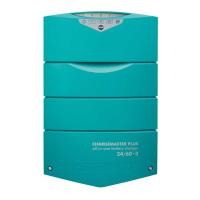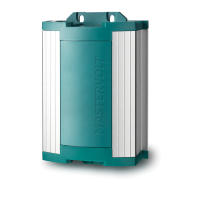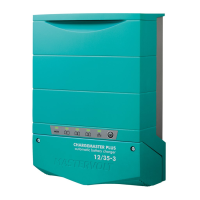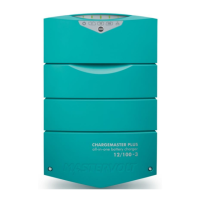ChargeMaster Plus 12/75-3, 12/100-3, 24/40-3, 24/60-3 –
User and Installation Manual
2.4 Warnings regarding the use of batteries
1 Only use ChargeMaster Plus for charging LEAD-ACID
batteries and the supply of users attached to these
batteries, in permanent systems. Do not use
ChargeMaster Plus for charging dry-cell batteries that
are commonly used with home appliances. These
batteries may burst and cause injury to persons and
damage to property.
2 NEVER charge non-rechargeable batteries.
3 NEVER charge a frozen battery.
4 Excessive battery discharge and/or high charging
voltages can cause serious damage to batteries. Do
not exceed the recommended limits of discharge level
of your batteries.
5 If it is necessary to remove a battery, always remove
grounded terminal from battery first. Make sure all
accessories are off, so as not to cause an arc.
6 Be sure that the area around battery is well ventilated
while battery is being charged. Refer to the
recommendations of the battery manufacturer.
7 Batteries are heavy! It may become a projectile if it is
involved in an accident! Ensure adequate and secure
mounting and always use suitable handling equipment
for transportation.
2.5 Charger location
1 Never place charger directly above battery being
charged; gases from battery will corrode and damage
charger.
2 Never allow battery acid to drip on charger when
reading electrolyte specific gravity or filling battery.
3 Do not operate charger in a closed-in area or restrict
ventilation in any way.
4 Do not set a battery on top of charger.
2.6 DC connection precautions
1 Connect and disconnect DC output clips only after
setting any charger switches to “off” position and
removing AC cord from electric outlet. Never allow
clips to touch each other.
2 Attach clips to battery and chassis as indicated in
section 2.7, steps 5 and 6, and 2.8 steps 2 through 4.
2.7 When battery is installed in vehicle
A SPARK MAY CAUSE BATTERY EXPLOSION.
To reduce risk of a spark near battery:
1 Position AC and DC cords to reduce risk of damage
by hood, door, or moving engine part.
2 Stay clear of fan blades, belts, pulleys, and other
parts that can cause injury to persons.
3 Check polarity of battery posts. POSITIVE (POS, P, +)
battery post usually has larger diameter than
NEGATIVE (NEG, N, –) post.
4 Determine which post of battery is grounded
(connected) to the chassis. If negative post is
grounded to chassis (as in most vehicles), see (5). If
positive post is grounded to the chassis, see (6).
5 For negative-grounded vehicle, connect POSITIVE
(RED) clip from battery charger to POSITIVE (POS,
P, +) ungrounded post of battery. Connect NEGATIVE
(BLACK) clip to vehicle chassis or engine block away
from battery. Do not connect clip to carburetor, fuel
lines, or sheet-metal body parts. Connect to a heavy
gage metal part of the frame or engine block.
6 For positive-grounded vehicle, connect NEGATIVE
(BLACK) clip from battery charger to NEGATIVE
(NEG, N, –) ungrounded post of battery. Connect
POSITIVE (RED) clip to vehicle chassis or engine
block away from battery. Do not connect clip to
carburetor, fuel lines, or sheet-metal body parts.
Connect to a heavy gage metal part of the frame or
engine block.
7 When disconnecting charger, turn switches to off,
disconnect AC cord, remove clip from vehicle chassis,
and then remove clip from battery terminal.
8 See operating instructions for length of charge
information.
2.8 When battery is outside vehicle
A SPARK MAY CAUSE BATTERY EXPLOSION.
To reduce risk of a spark near battery:
1 Check polarity of battery posts. POSITIVE (POS, P, +)
battery post usually has a larger diameter than
NEGATIVE (NEG, N, –) post.
2 Attach at least a 24-inch-long 6-gauge (AWG)
insulated battery cable to NEGATIVE (NEG, N, –)
battery post.
3 Connect POSITIVE (RED) charger clip to POSITIVE
(POS, P, +) post of battery.
4 Position yourself and free end of cable as far away
from battery as possible – then connect NEGATIVE
(BLACK) charger clip to free end of cable.
5 Do not face battery when making final connection.
6 When disconnecting charger, always do so in reverse
sequence of connecting procedure and break first
connection while as far away from battery as practical.
2.9 Preparing to charge
1 If necessary to remove battery from vehicle to charge,
always remove grounded terminal from battery first.
Make sure all accessories in the vehicle are off, so as
not to cause an arc.
2 Be sure area around battery is well ventilated while
battery is being charged.
3 Clean battery terminals. Be careful to keep corrosion
from coming in contact with eyes.
4 Add distilled water in each cell until battery acid
reaches level specified by battery manufacturer. Do

